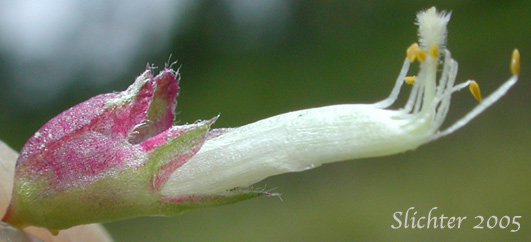
 The photo above shows a close-up of the pistil and densely bearded
tip of the style (looks like a whitish bottlebrush at upper right) which helps
distinguish this species from the very similar peavines or leafy peas (genus
Lathyrus) which have hairs along
only one side of the style.
The photo above shows a close-up of the pistil and densely bearded
tip of the style (looks like a whitish bottlebrush at upper right) which helps
distinguish this species from the very similar peavines or leafy peas (genus
Lathyrus) which have hairs along
only one side of the style.
American vetch is a perennial wildflower with one to several reclining to climbing stems that zigzag from 2-24 cm long. The stems and leaves typically range from glabrous to coarsely pubescent. The leaves are alternate along the stems and are pinnately compound. The 4-7 pairs of leaflets are lanceolate, oblong, or elliptic in outline with variable tips, ranging from acute to truncate, often ending in a long point (See photos.). Individual leaflets range from 2-4 cm long and typically are sparsely haired. Prehensile tendrils with several branches typically are found at the tip of each leaf.
The peduncles are generally shorter than the leaves and are capped with a raceme of 2-10 bluish-purple flowers measuring 15-25 mm long. The banner is ascending to erect while the wings tend to be longer than the keel. The calyx is covered with loose spreading hairs, especially along the margins. The short calyx is about one-third as long as the corolla and has 5 unequal teeth which are about one-half the length of the corolla tube. The lowest 3 calyx teeth tend to be the longest as seen above. The style is sharply bent upwards and is rounded in cross-section. It is capped by a tuft of spreading hairs for the last 1 mm of its length, the hairs spreading in all directions. The pods are glabrous and measure 2.5-4 cm long (See photo below.).
American vetch may be found in open woods, along roadsides, and in forest meadows from the lowlands to well up into the mountains.
American vetch may be found from southern Alaska south through the Pacific Northwest to California and Mexico and east to Ontario and south to Wyoming, Missouri and West Virginia.
In the Columbia River Gorge, it may be found between the elevations of 100'-4200' from the Sandy River eastward to near Horsethief Butte.